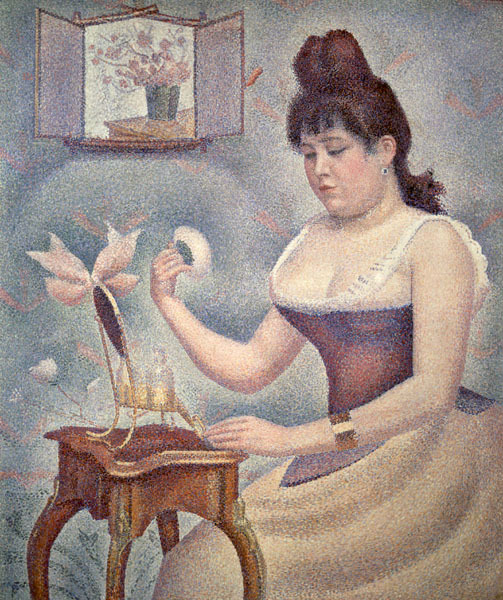
Léon Pourtau
Marie-Eulalie à sa toilette
1890
Oil on canvas
59,05 x 35,04 in
Signed upper left: « L. Pourtau »

1_Georges Seurat (1859-1891)
Jeune Femme se poudrant, 1890
Courtauld Gallery, Londres.

2_Detail.
When marrying Léon Pourtau on October 23rd, 1890, Marie-Eulalie Vallad embraced the bohemian lifestyle of the painter musician. The young couple settles in the heart of Montmartre; on 13 rue Ravignan. The atmosphere conducive to artistic creativity prevailing in this Parisian neighborhood, enables the young groom to release his talent as a painter. When he returns from his evening rehearsals of the Colonne orchestra held at the Chatelet theater and where he is a clarinetist, his highest wish is to paint. It is with the enthusiasm and dynamism of a happy husband and a notable artistic passion that he portrays Marie-Eulalie à sa toilette.
Though many neoimpressionist painters such as Henri-Edmond Cross, Camille Pissarro and Maximilien Luce have painted young woman at their toilette it is in Georges Seurat’s Jeune femme se poudrant (1888-1890)1 that the law of the simultaneous contrast of colors seems the most mastered. However, Léon Pourtau’s Marie-Eulalie à sa toilette, threatens the established order in the neoimpressionist world. Indeed, Pourtau’s masterpiece is an example of this genre. The technique mastered by the young artist, as well as his bold approach to painting, rank him amongst the most important representative of the new school.
Taking advantage of a ray of sunshine passing through the curtain, Marie-Eulalie is applying blush on her cheeks. While the whiteness of her face matches the immaculate tones of her blouse, her scarlet skirt recalls the lipstick she applied.
Laying on the table behind her, a still-life worthy of the greatest Dutch Golden Age painters, underlines this color contrast and perfectly settles the scene in the space. The regularity of the stroke used to render the wooden floor enhances the verticality of the scene and therefore conveys to the spouse an outstanding omnipresence. A vanity mirror, same as the one she holds in her hand, is hanged on the printed wallpaper, therefore attracting the spectator’s view toward the upper part of the canvas where the mirror is hanged next to the artists signature.2
Through the mural mirror the painter realizes a mise en abyme that recalls the paintings of the greatest Dutch Golden Age painters or Spanish painters. Therefore part of the composition, Léon Pourtau wishes to show his happiness to the viewer but also assert himself as a painter amongst his colleagues. In Jeune femme se poudrant, Seurat also realized a mise en abyme; a mirror reflected his bearded face in the same way Pourtau did in Marie-Eulalie à sa toilette. According to the last studies regarding Seurat’s painting, it seems that the neoimpressionist master decided at the last moment to withdraw this scene from his painting and to replace it by a bouquet of flowers. Both paintings are from the same chronological era, but it seems that Léon Pourtau is more innovative than his eminent colleague too mindful to stray from bourgeois considerations. After Léon Pourtau’s death, Marie-Eulalie à sa toilette has been kept for several hundred years in a barn. It was not only 1990 that an enlightened amateur brought it back to life.
Gilles Caillaud
